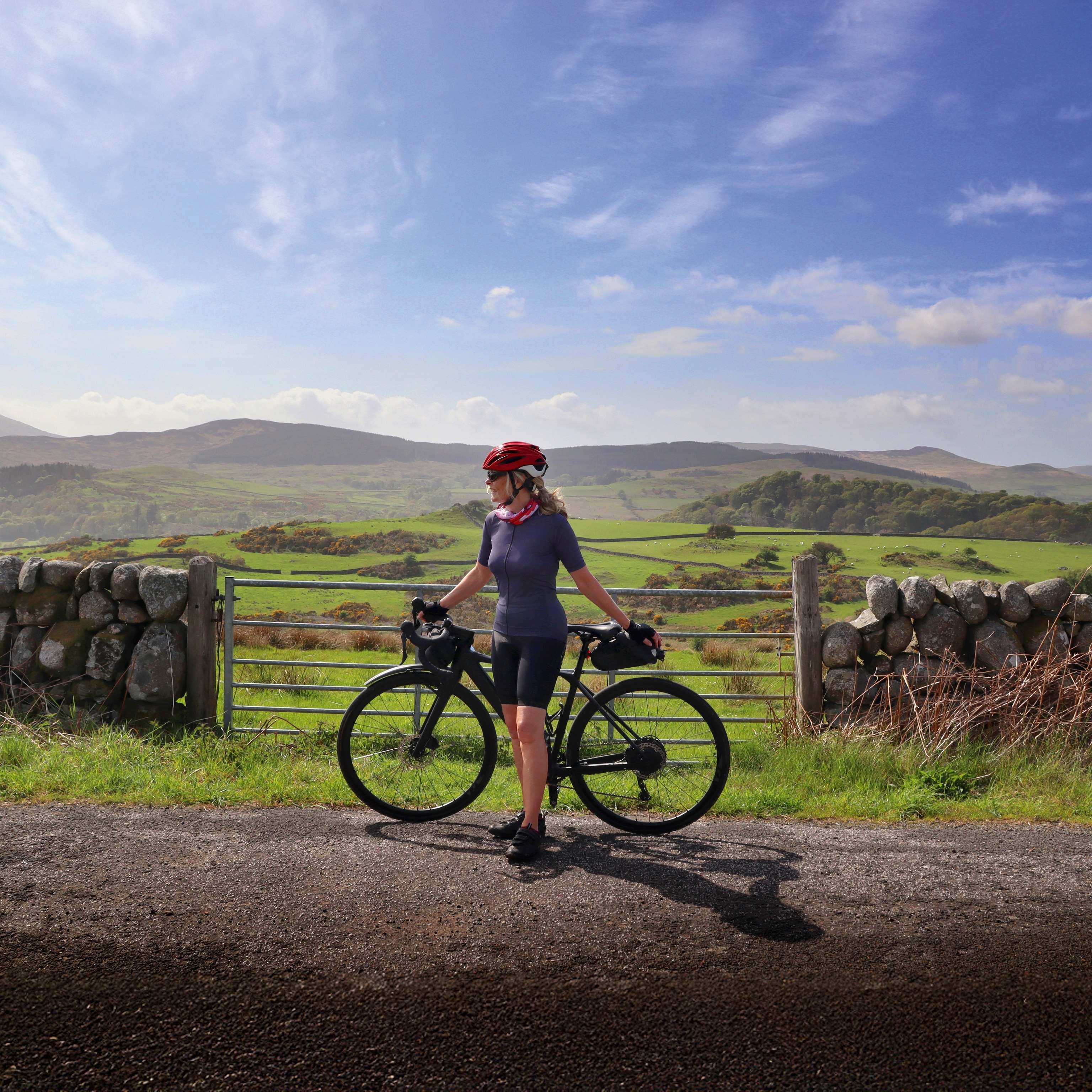American Bike Project: Where to Sleep
Here are some tips for where to sleep when cycling across the U.S.
If travel experiences were judged solely based on the number of different places a traveler slept during a single trip, bike touring might win a prize as the best form of travel. Though I don’t believe this is how a travel experience should be judged (and I have had some of my greatest travel experiences by simply planting myself in a single neighborhood for the duration of a trip), I do believe bike touring offers an extremely unique form of travel where a lot can be seen over a short period of time.
Naturally, bike touring is an excessively transient form of travel, and it is likely that a touring cyclist will sleep in a different city or town nearly every night of their journey. In my case, as I make my way across the United States via the TransAmerica bike route, I have at this point laid my head in 70 different spots over the course of 80 days (with about 20 more days to go before reaching my end destination). I have stayed multiple nights in the same place only seven times during my trip, and of those seven times, I have stayed in only one place for more than two nights.
While engaging in such travel, where does one lay their head every single night, night after night? This is the question I asked myself before departing on my bike tour, and one that I admittedly experienced a bit of anxiety over while planning my route. In general, finding a place to sleep at the last minute can often result in some of the most frustrating, exciting, and even scary moments of a trip. But mapping out a place to stay each night for a 75-plus-day bike tour is difficult to do, and even if it is done, sticking to such a strict schedule is nearly impossible. Plans change all the time on a bike tour, so in the end, one must ride with a mentality of extreme flexibility.
Having now spent nearly 3,500 miles on the road, I have a better idea of how this works and have discovered a few tricks and tips for finding places to sleep while bike touring.
Campsites
The most obvious option for finding a good place to sleep on a bike tour is dedicated campsites. Depending on the route, a bike tour in America might take you through a number of national parks, state parks, and national forests. These areas provide a number of options for travelers looking to reserve tent campsites at a relatively cheap cost. Campsites can range anywhere from five dollars to $35, so tent camping is often a good option if you’re looking to travel on a budget. Campsites also usually offer running water and restrooms, and at times are located near park visitors centers, which often have restaurants or small convenience shops. Finally, many sites contain fire pits, and sitting next to a warm, crackling fire after a long day of cycling is, in my opinion, the best way to end a day.

Hotels and Motels
During a traditional travel experience across America, hotels and motels are a common option. The TransAmerica bike route regularly passes through multiple towns every 30 to 40 miles, so I have found hotels and motels to be plentiful. During a 75-plus-day cross-country bike tour, however, staying in a hotel every night would quickly become pricey. For this reason, I generally reserve hotels and motels as last-resort options. I might choose to stay in a hotel or motel if it offers some sort of historical significance or unique appeal to the area (such as Portland’s McMenamins Kennedy School, an elementary school turned hotel/movie theater/restaurant/billiards hall that fully embodies the spirit of Portland), but this has rarely been the case during my bike tour. I therefore avoid shelling out cash for hotels or motels in favor of options that are cheaper and generally more authentic to a place.
Hostels
Hostels provide some of the greatest options for cyclists looking to find comfortable and cheap lodging on a tour. Hostels usually provide all of the same amenities of a hotel (such as laundry services, showers, a roof over one’s head, and a soft bed to sleep in) but with the added benefit of lower costs and, in many cases, the opportunity to socialize with fellow travelers in a welcoming setting. I have stayed in a number of great hostels along the TransAmerica bike route, and I recommend my favorites to every cyclist I meet who is traveling in the opposite direction.
One of the most scenic of these hostels was the American Alpine Club Climbers’ Ranch in Grand Teton National Park. The ranch (which is essentially a hostel) sits at the base of Grand Teton mountain, is a short walk from a handful of great hiking trails, and for only $25 a night provides a bunk in one of the ranch’s many shared log cabins. Cooking and food are prohibited in the cabins, so all guests are required to do all of their mealtime activities in the ranch’s kitchen area, which is an open, wooden pavilion set directly in the center of the cabins. This setup places guests together and provides a good opportunity for travelers to share stories as they cook each night. As an added benefit, the ranch also sits next to a dedicated bike path that connects the park to Jackson, Wyoming, with 20 miles of smooth, rolling pavement free of any automobile traffic.
Alternatively, a great urban hostel option found on the TransAmerica trail is the Shady Spruce Hostel in Missoula, Montana. The hostel is extremely clean, is packed with modern amenities, has two communal kitchens, and has a nice tree-shaded deck out front with hammocks and lawn chairs. It is one block away from the Adventure Cycling headquarters, and one more block away from Missoula’s main street, Higgins Avenue, which is lined with great breweries, restaurants, and a scenic park next to the Clark Fork River.
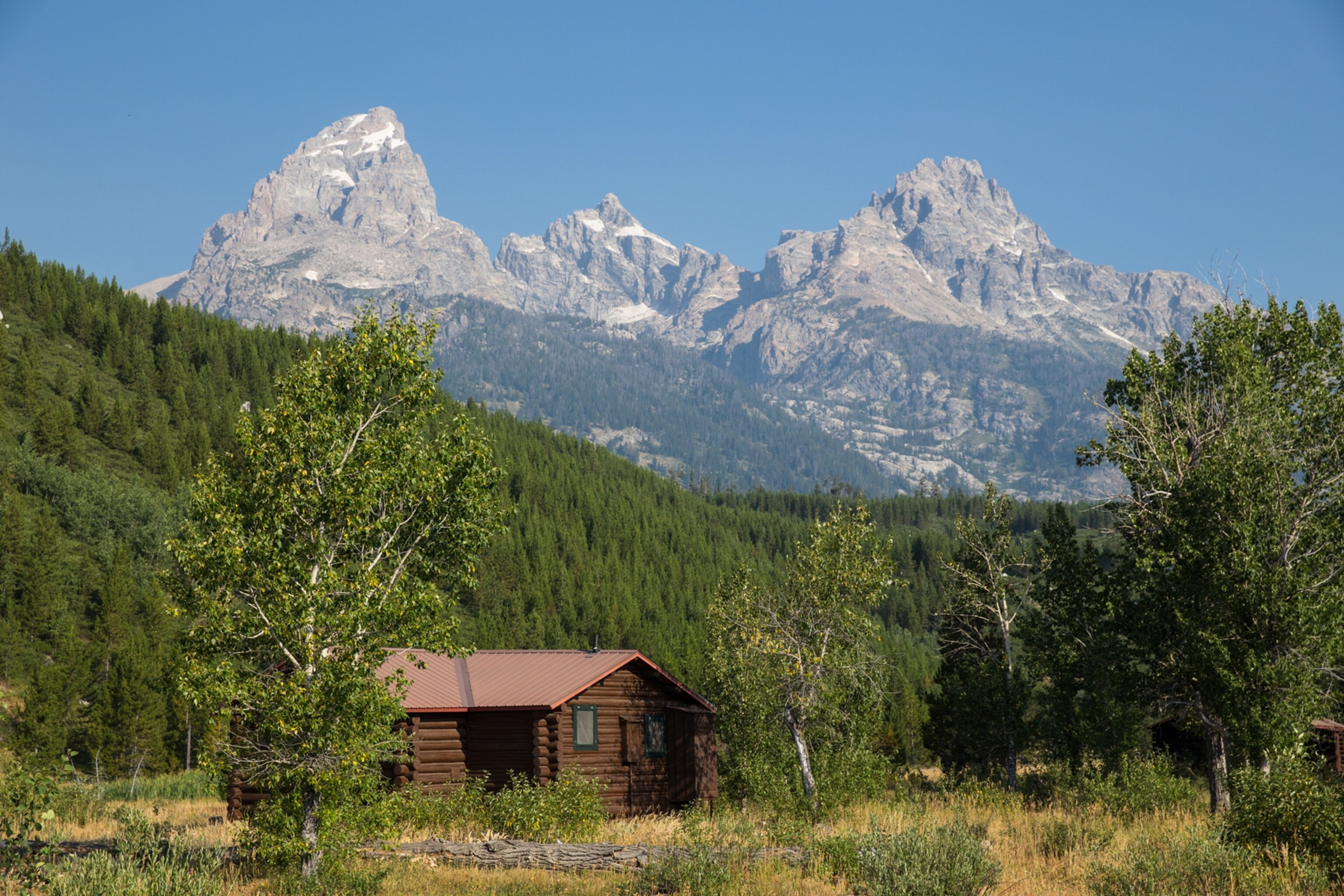
Other notable hostels on the TransAmerica route include the Baker City Bike Hostel in Baker City, Oregon; the Spoke’n Hostel in Mitchell, Oregon; and Al’s Place in Farmington, Missouri. Each of these hostels costs less than a hotel, is spacious and clean, and has friendly, welcoming owners. A few hostels are even exclusive to cross-country cyclists. If you find yourself in a city and are looking to spend a night indoors, do a quick Google search for hostels before opting to stay in an overpriced hotel. Who knows? You might just meet someone who could change your life.
City Parks
One of the most surprising options for laying my head to rest during a bike tour has been city parks. Many small towns of a thousand people or fewer are happy to have cyclists stay in their city parks, and most simply request that cyclists call the local sheriff to inform them of their stay. If you can get over the feeling that sleeping in a city park might make you feel like a homeless wanderer (in my case I am homeless), sleeping in city parks is a surprisingly great option. Out of all the times I have requested to sleep in a city park, I have never once been turned down by a city’s office, and out of the 80 days I have spent biking across the country, I have spent 15 nights sleeping under city park pavilions. All were enjoyable experiences. This is not only a great setup for cyclists, it also benefits small towns that welcome money from traveling cyclists looking to set up camp and then hop over to the local diner for dinner or breakfast—or both. Many small-town parks are clean, have plenty of shelter, provide access to public restrooms, and are free.
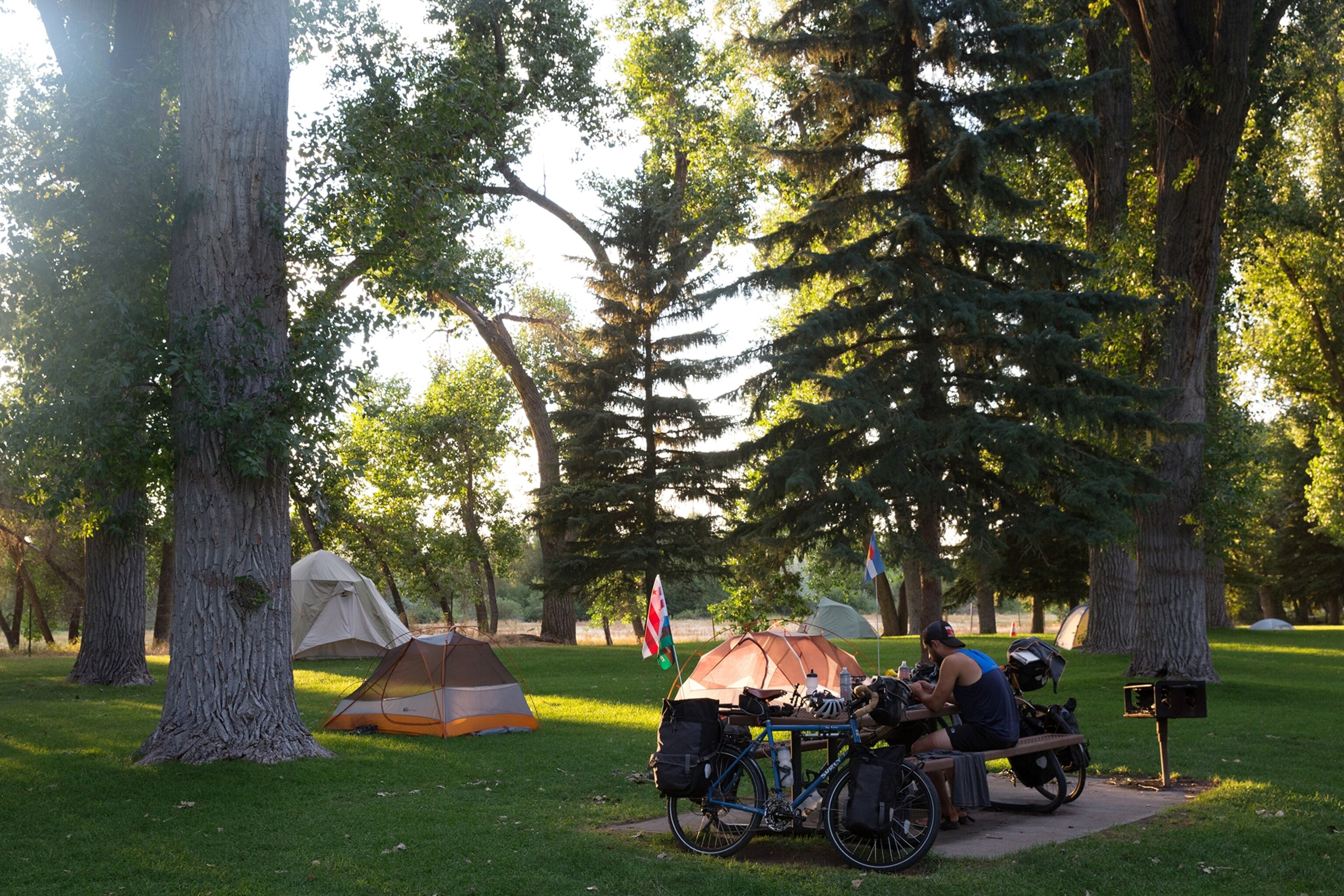
Churches
“Back in 1975, the organizers of the first cross-country bike route (then called Bikecentennial) made phone calls to various individuals and organizations along the route, asking if they would be willing to host cyclists the following summer,” said Bayou, a volunteer with a church in Damascus, Virginia, who gave me this brief history on why his church started hosting cyclists. “They called us, and we agreed to host cyclists if they agreed to help turn one our buildings into a hostel.”
The church has been hosting hundreds of cyclists (and hikers) every summer since. This seems to be the case with a number of other churches across the country as well, and I have found churches to be great places to stay during my bike tour. Sleeping in a church usually involves unrolling my inflatable sleeping pad on a floor between church pews, but the prospect of sleeping indoors on a hot or stormy night is always a welcome option. The Adventure Cycling Organization keeps track of churches willing to host cyclists, and these can be located by checking the lodging options on any of the Adventure Cycling Association bike-route maps.
A New Friend's Couch
- National Geographic Expeditions
If you are looking to interact with and stay with locals during a bike tour, WarmShowers.org and CouchSurfing.com are excellent options. In most cases, these hosts are simply looking to give back to a community of travelers that they were once a part of, and during my trip so far, I have had only great experiences. Both options are good, but WarmShowers.org is a bikers-only travel community and offers a lot of great host options along popular bike routes. Though amenities and sleeping options will range from host to host, they all offer the same welcoming personalities and local insight. If you’re considering staying with a host, chat with cyclists who are traveling in the opposite direction. Many hosts establish legendary reputations on the trail, and a number of times I have passed cyclists traveling in the opposite direction who insist that I stay with a particularly great host. If you opt to stay with a WarmShowers.org or CouchSurfing.com host, be courteous and pay attention to requests such as each host’s maximum number of guests allowed and minimum arrival-time notice needed. These people willingly host travelers all summer long, so abiding by their requests is a great way to help them out.
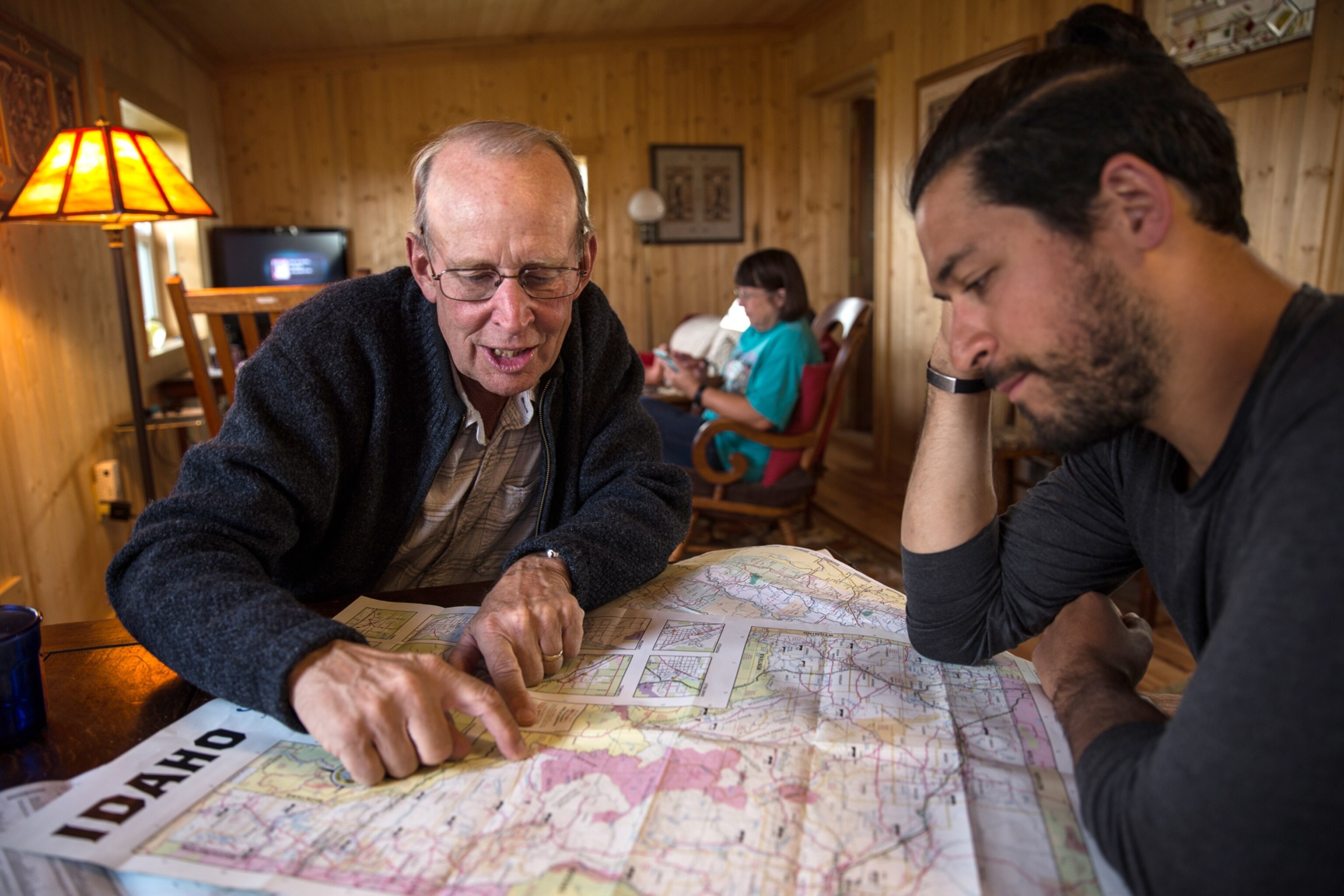
Improvisation
Perhaps the most exciting way to find a place to sleep comes in the form of pure improvisation and random luck. Over the course of my tour I have slept in a barn, a fire station, the homes of strangers, and makeshift campsites in remote wilderness areas. Improvisation captures the essence of bike touring and can make for some of the most memorable moments on the trail.
Recently, my traveling companion, Adam, and I found ourselves in Jackson, Wyoming, late in the evening with no place to stay. I was experiencing ankle pain from a wreck a few months earlier and planned to see a doctor the following day. We could not bike the 15 miles out of town to the nearest campsite and did not want to spend the money on an expensive hotel in Jackson, so our options were thin. As we moved through town considering alternatives, a man on a bike stopped us to ask what we were looking for. We mentioned that we were looking for a cheap place to stay near town, and without hesitation he offered his home to us. As we came to find out, this man (who also happened to be named Tyler) had biked across the country years earlier, and had been taken care of by a small community of generous people after experiencing a bad bike wreck in a small town. Ever since, he had been hoping for the chance to give back to traveling cyclists, and when he saw us he jumped at the opportunity. We were grateful to spend two nights at his home, sharing stories from our trips, eating home-cooked food, and soaking in the generosity of strangers.
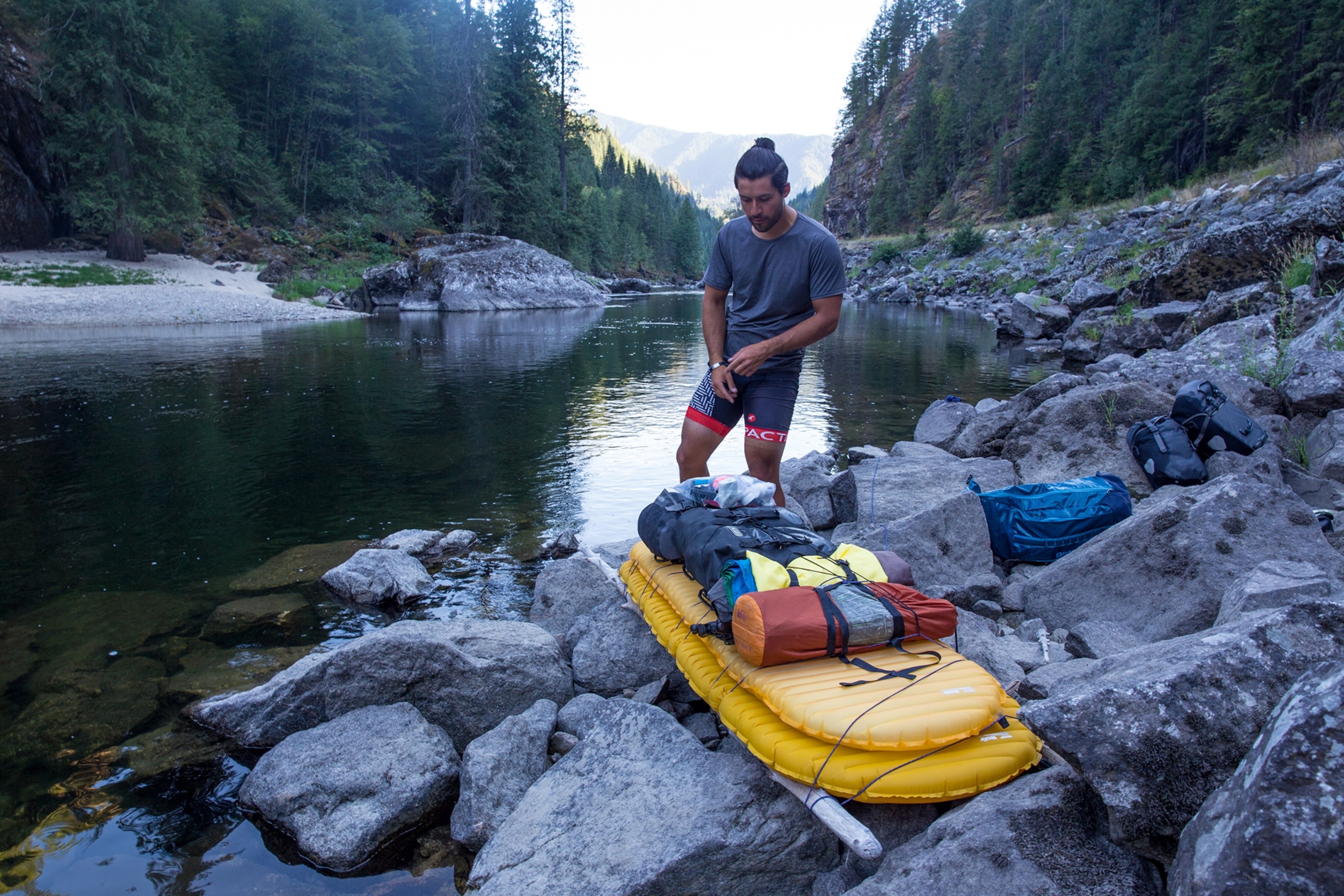
In another instance of spontaneity, Adam and I found ourselves biking along the scenic Lochsa River in northern Idaho, looking for a campsite. This stretch of the TransAmerica has no towns and no services for 66 miles, so camping was our only option. Late in the afternoon we noticed an ideal-looking beach on the opposite side of the river. The beach was a soft bed of white sand about a hundred yards wide and 50 yards deep, and was flanked on either side by two giant Douglas fir trees. A giant stone wall backed the entire thing, making the bank look like a movie set. It looked like a perfect campsite—but only if we could get there. The river would be too deep to move our bikes and gear across, so after some brainstorming, we decided to construct a raft out of driftwood and our inflatable sleeping pads. Over the course of a few adventurous hours, we piled gear onto the raft (crossing our fingers that it would float), swam it across the river to the beach, and made our way back for more gear. By sunset we had successfully moved all of our camping supplies onto the beach, and we spent the night filled with a sense of adventure and reward.
It is moments like these that make traveling by bike a truly rewarding and unique experience. Allowing oneself to be swept up in a moment of improvisation can make finding a place to sleep each night of a bike tour a much more enjoyable experience, and it can open up a dose of adventure on any trip.
If you’re considering traveling by bike, don’t be intimidated by the prospect of planning out every single night of your trip. Create a loose structure around where you might want to travel, look for any major obstacles along your route (such as long sections with no dedicated campsites or lodging options), and go into your bike tour prepared to improvise when needed. Once you hit the road, things will start to come together. In the end, a bike trip should be a freeing, enjoyable experience, so get out there and embrace adventure!

